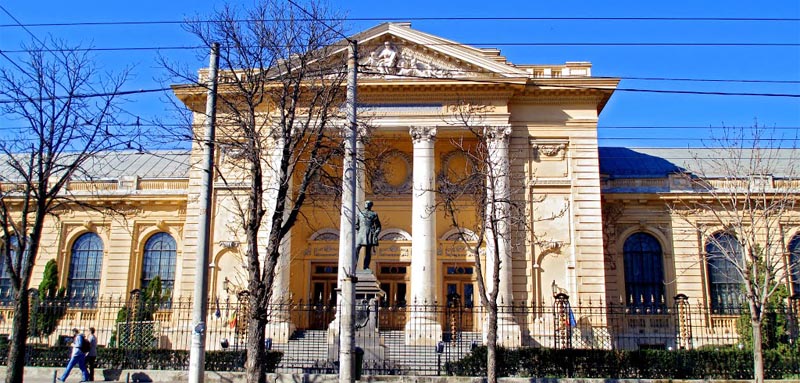
INTRODUCTION
Carol Davila University of Medicine and Pharmacy is a state-run health sciences University in Bucharest, Romania. It is the largest institution of its kind in Romania with over 2.865 employees, 1.654 teachers and over 4.800 students. The University is using the facilities of over 20 clinical hospitals all over Bucharest.
It was initially established in 1857 under the name National School of Medicine and Pharmacy by the French expatriate physician, Carol Davila. In 1869 it was incorporated as a department in the newly created University of Bucharest. The first doctoral degrees were granted in 1873, and the doctoral degree became the de facto graduation in 1888.
The School of Pharmacy was founded in 1889 and it was renamed, as the Faculty of Pharmacy in 1923.The Faculty of Pharmacy of Carol Davila University is the place where insulin was isolated for the first time by Nicolae Paulescu in 1921.
The higher medical and pharmaceutical education in Bucharest dates back more than a century. Carol Davila, a Romanian physician of French origin, in collaboration with Nicholae Kretzulescu founded the medical education in our country, by establishing in 1857 the National School of Medicine and Pharmacy. Thanks to his activity a number of scientific societies were born in our country such as "The Medical Society" (1857), "The Red Cross Society" (1876), "The Natural Sciences Society" (1876), and two medical journals: "The Medical Monitor" (1862) and "The Medical Gazette" (1865). In the war for independence (1877-1878) he led the army's military service.
The building of the Faculty of Medicine was fully completed and inaugurated on the 12th of October 1903 when was inaugurated also of the statue of Carol Davila, seated in front of the faculty. The initiative to erect a monument to Davila was taken at the first national medical conference held in Bucharest in October 1884. The statue, valued work of Carol Storck, was cast in bronze in the School of arts and crafts workshops in Bucharest.
The inauguration of the faculty building is an important date in the evolution of medical education in Bucharest. The new building brought great improvements in the functioning of laboratories and the organization of practical work, as well as in the full didactic activity. He sheltered for a while also a part of the pharmacy department.
With all the difficulties encountered, the National School of Medicine and Pharmacy has developed gradually, and on 12 November 1869, it became possible fthe oundation of the Faculty of Medicine in Bucharest, which opened its courses on the day of 22th November 1869. It was the first faculty of medicine at the University of Bucharest, and also on our country's teritory; it was through it that the medical science has managed to establish itself, both at home and abroad.
Among the teachers who helped develop the education in the Faculty of Medicine in Bucharest are Carol Davila, Iacob Felix (1832-1905), founder of school of hygiene, with preoccupation for general medicine, Alexandru Marcovici (1835-1886), initiator of the medical clinic, Nicolae Turnescu (1819-1890) and Constantin Dumitrescu-Severeanu (1840-1930), founders of the surgical clinic, Zaharia Petrescu (1841-1901), founder of medical therapeutics; Alexandru Sutzu (1837-1919), which lays the foundation of legal medicine and psychiatry.
An important event in the Romanian pharmacy and therapeutics trend was represented by the apparition, in early 1863, of the first Roman pharmacopoeia. A very special merit in making this national act had, in addition to its initiator Carol Davila, Constantin C. Hepites pharmacist scholar (1804-1890), former professor at the School of Medicine.
In 1873, the first doctoral thesis at the Faculty of Medicine in Bucharest were sustained. Until 1888 a total of 19 bachelor's degree in medicine are sustained, along with doctoral theses. Since the academic year 1885, students without a Baccalaureate diploma are no longer admit and university graduates after 1888 should support a thesis, thus obtaining a doctorate in medicine and surgery.
Another event occurred in the college life was the creation on 1 January 1875 under the initiative of the future professor Nicolae Manolescu (1850-1910), of the Medical Students Society in Bucharest, which initially put its aim to improve the conditions of study.
The year 1887 marked a new stage in the development of the Faculty of Medicine in Bucharest, and a memorable date in the history of Romanian science. In that year, three eminent scientists were called in as a teacher in charge of key departments of the faculty. Victor Babes (1854-1926), one of the great bacteriologists and pathologist of his time, George Assaky (1855-1899), founder of experimental surgery and Nicolae Kalinderu (1832-1902), emMBBS study in UK and USAinent clinician, the initiator of the clinical anatomical orientation in the Romanian medicine.
After 1890, other scientists fill academic staff of the Faculty of Medicine in Bucharest; in 1895 is appointed professor of clinical surgery and topographic anatomy Thoma Ionescu (1860-1926), founder of the Romanian modern surgery, innovator in the field of spinal; in 1899, Gheorghe Marinescu (1863-1938), founder of the Romanian school of neurology, in 1901, Ion Cantacuzino (1863-1934), biologist and bacteriologist, immunologist and epidemiologist, creator of the Romanian school of experimental medicine. After World War I, the Faculty of Medicine's departments are illustrated also by other personalities which have enhanced the prestige of the faculty. Among them we include: Professor Ion Nanu Muscel (1862-1938), clinician and school creator; Anibal Theohari (1873-1933), creator of balneology and experimental therapeutics; Professor Ernest Juvara (1870-1933), innovator in the surgical and instrumental technique; Professor Alexandru Obregia (1860-1937), who illustrated the science of psychiatry; Professor Mina Minovici (1858-1933), creator and organizer of the scientific legal medicine in Romania; Franz Rainer (1874-1944), anatomist and anthropologist scholar, Constantin I. Parhon promoter of endocrinology and biochemistry; Dimitrie Bagdasar (1893-1946), founder of school of neurosurgery; Constantin Ionescu-Mihaiesti (1883-1962), representative of the Romanian School of Microbiology, the organizer of internships sera, one founder of the Institute "Dr. I. Cantacuzino".
In 1898, the School of Pharmacy becomes part of the Faculty of Medicine, thus being recognized its character of an institution of higher education. It works in this situation near the faculty of medicine until 1923, when it was founded the School of Pharmacy, as a separate institution, within the University of Bucharest. An important role in the creation of the Faculty of Pharmacy and in the stimulation of pharmaceutical scientific research had Professor Stefan Minovici (1867-1935).
Faculties Of University Carol Davila
Medical Faculty of Carol Davila University
The faculty of Medicine in Carlo Davila University of Bucharest is the largest medical faculty in Bucharest. It has English and Romanian programs and attracts hundreds of international students and medical residents and Doctorate students.
- Bachelor in Medicine - 6 years, full-time attendance (English and Romanian)
- Bachelor in Nursing (Registered nurses) - 3 years, full-time attendance
- Bachelor in Nursing for Imaging and Radiology - 3 years, full-time attendance
- Bachelor in Clinical Laboratory Nursing - 3 years, full-time attendance
- Bachelor in Nursing for Balneo-physiotherapy and Recuperation - 3 years, full-time attendance
- Bachelor in Nursing for Nutrition and Dietetics - 3 years, full-time attendance
Faculty Of Medicine
The higher medical and pharmaceutical education in Bucharest dates back more than a century. Carol Davila, a Romanian physician of French origin, in collaboration with Nicholae Kretzulescu founded the Medical education in Romania, by establishing the National School of Medicine and Pharmacy in 1857. Thanks to his activity a number of scientific societies were created, such as "The Medical Society", "The Red Cross Society", "The Natural Sciences Society" and two medical journals, "The Medical Monitor" and "The Medical Gazette".
The building of the Faculty of Medicine was fully completed and inaugurated on 12 October 1903. The initiative to erect a monument to Carol Davila on the same day was taken at the first national medical conference, which was held in Bucharest in October 1884. The statue, valued work of Carol Storck, was cast in bronze in the School of arts and crafts workshops in Bucharest.
The inauguration of the faculty building is an important date in the evolution of medical education in Bucharest. The new building brought great improvements in the functioning of laboratories and the organization of practical work, as well as in the full didactic activity.
Dentistry Faculty of Carol Davila University
- Dental Medicine - 6 years, full-time attendance (in Romanian)
- Dental Technique - 3 years, full-time attendance
- Registered Nurses in Dentistry - 3 years, full-time attendance
- Pharmacy - 5 years, full-time attendance (French, Romanian)
- Assistants - 3 years, full-time attendance.




